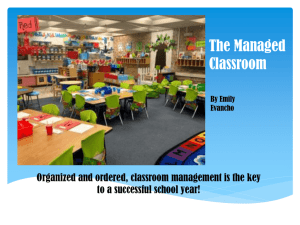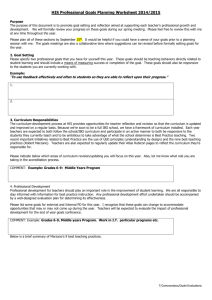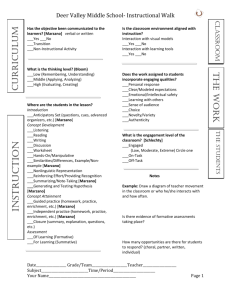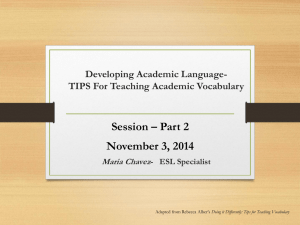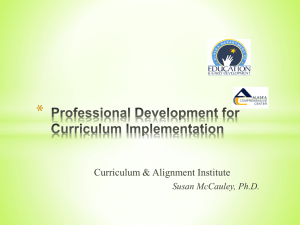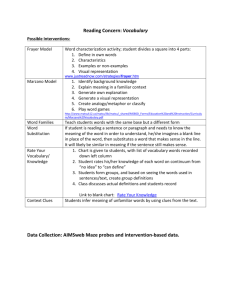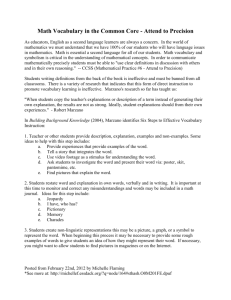Classroom Management Part 2
advertisement
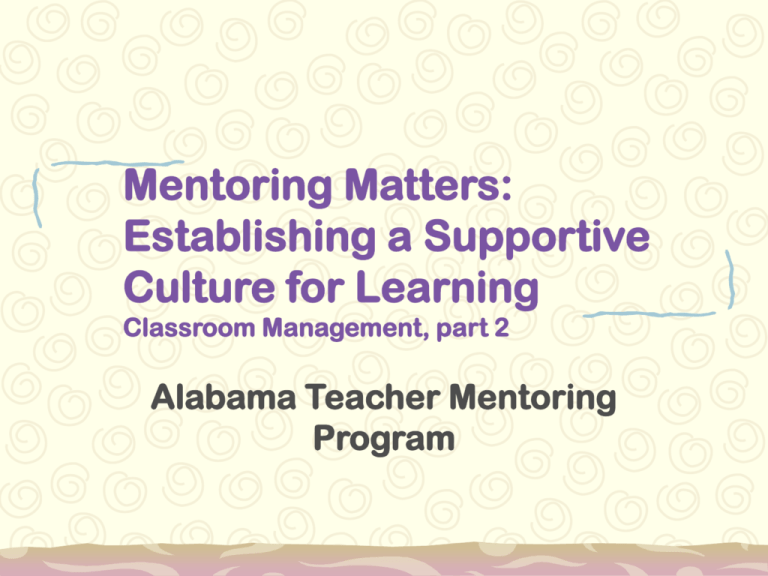
Mentoring Matters: Establishing a Supportive Culture for Learning Classroom Management, part 2 Alabama Teacher Mentoring Program Learning Outcomes Mentors will be able to: Talk about the importance of classroom management—in particular, “mental set” and “withitness”—and help beginning teachers understand and learn these skills. Understand the relationship between positive teacher-student relationships, student behavior, and student achievement Consider ways to help a beginning teacher reflect on the extent to which he or she creates a community of learners, in which students are motivated to learn Talk with colleagues in confidence about successes and challenges of mentoring a beginning teacher Agenda Review/Learn – Review four components of classroom management; think about the value of an appropriate “mental set.” Sharing – Think about positive teacher-student relationships and what they look like. Learning – Classroom management, part 2: research about teacher-student relationships and teacher mental set; strategies to accomplish these Committing – What ideas can I use? What have I learned? What will I use with my mentee? Three Major Roles of Effective Teachers (Marzano) 1. Selecting effective and appropriate instructional strategies 2. Designing curriculum with appropriate pacing and sequence 3. Managing the classroom to promote efficient and effective learning Marzano’s Meta-Analysis Reported in Classroom Management that Works: Research-Based Strategies for Every Teacher. Included the findings from more than 100 different studies Addressed four general components of classroom management, each of which has a positive relationship to student engagement and student achievement. Four Components of Classroom Management (Marzano) Rules and procedures Disciplinary interventions Teacher-student relationships Mental set Summary of Marzano Findings “Students in classes where effective management techniques are employed have achievement scores that are 20 percentile points higher than students in classes where effective management techniques are not employed.” Students in these classes have a 23 percent higher engagement rate. Marzano, p. 10 Appropriate Mental Set Of Marzano’s four components, mental set has the largest effect on student behavior, engagement, and achievement. Mental Set = Frame of Mind The Mental Set of Effective Classroom Managers Incorporates two Constructs: 1. Withitness (with-it-ness) 2. Emotional Objectivity What is the “Mental Set” of Effective Teachers? They are “mindful” of what’s happening. – They pay attention – They don’t get absorbed in what they’re doing to the exclusion of what’s going on around them – They stay tuned in to the students “Mindfulness involves a heightened sense of situational awareness and a conscious control over one’s thoughts and behavior relative to that situation.” (Marzano, CMTW, p. 65) Withitness Kounin discovered the difference between effective and ineffective teachers was “not in how they handled the disruptive behavior of students, but in the disposition of the teacher to quickly and accurately identify problem behavior or potential problem behavior and to act on it immediately.” Marzano, p. 66-67 Techniques of “With-it” Teachers Position themselves to be able to see all students…and move around the classroom, getting to all sections Periodically scan the classroom Pay attention to potential problems Make eye contact If eye contact doesn’t work, move closer If moving closer doesn’t work, say something privately to the student --Marzano, p. 70 “With-it” Teachers Forecast Problems What might go wrong? Anticipate problems— particularly with special needs students To Learn With-it-ness, Observe Master Teachers Teachers develop withitness over time—it’s a subtle and situational quality Another Component of the Mental Set of Effective Teachers Emotional Objectivity = reacting to student misbehavior in a calm, unemotional, objective fashion—not personalizing student behavior More typical human reaction to disobedience is to feel hurt or angry; this undermines classroom management Consciously Reframe— Look for Reasons Why Don’t personalize student misbehavior Monitor One’s Own Thoughts Mentally review students before class each day—particularly the potential problems Try to imagine these “problem” students engaging in positive behavior Keep positive expectations in mind when interacting with these students Take Care of One’s Self! Address One’s Own Emotional State “…it is critical for you not to carry anger, resentment, and other hostile feelings once a discipline situation is over. If you are angry with a student from an incident that happened the day before, you might enter a power struggle just to flex your muscles and show who is boss. Don’t. Start fresh each day.” --Curwin and Mendler cited in Marzano, p. 74 Strategies to Enhance Emotional Objectivity Guided imagery Deep breathing Maintaining a sense of humor Laughter—going to movies or watching t.v. shows that one finds funny Treating oneself to a reward on especially hard days Emotional Objectivity Rate your beginning teacher on the extent to which he is able to stay objective when dealing with problem students. What feedback would you like to give him about this? – Remember, to be effective, praise should be specific, contingent, believable, and varied. How might you phrase the feedback? – Corrective feedback sometimes is more effective as the result of self-assessment and reflection. What questions might you pose to your beginning teacher on this topic? How Well is Your Mentee Taking Care of Himself? Find a partner with whom to talk. What evidence do you have that the beginning teacher with whom you work is taking care of herself…or failing to do so? (Remember the typical emotional phases of beginning teachers. See your Mentor Manual.) How could you help? Could you find time to do “deep breathing” together? Or go to a funny movie together? Alabama Quality Teaching Standards Standard 2: Teaching and Learning – Organization and Management of Learning – Using Instructional Strategies to Engage Learners – Assessment of Learning Standard 2: Teaching and Learning Organization and Management of Learning 2.1 Designs a classroom organization and management system built upon sound, age-appropriate expectations and research-based strategies for promoting positive behavior 2.2 Creates a climate that promotes fairness and respect 2.3 Creates a safe, orderly, and stimulating learning environment that nurtures motivation and engagement of learners What Does It Mean To You? Imagine a classroom with a climate of fairness and respect…that is safe, orderly and stimulating…and that nurtures student motivation and engagement (2.2 and 2.3) In such a classroom, what would the teacher be doing? What would students be doing? What would it feel like? Sound like? Look like? Is this classroom more like… A forest? A garden? A lake? A beach? Teacher-Student Relationships: The Keystone for Effective Classroom Management Study of over 10,000 adolescents found that “positive connections” to parents and teachers was the strongest factor to protect teens from destructive and risky behavior. by Resnick et al. (1997) Teacher-Student Relationships: The Keystone for Effective Classroom Management “When students feel connected at school, they are less likely to engage in violence, drugs, alcohol, sex, or other harmful behaviors.” (Vitto, page 8) Teacher-Student Relationships: The Keystone for Effective Classroom Management Resnick also found that positive relationships with teachers was more important than – class size, amount of teacher training, classroom rules, school policy …in protecting students from destructive behaviors. Teacher-student Relationship “The teacher-student relationship is easily lost in a confusing web of rules, limits, and required objectives.” Rogers and Frieberg (1994, p. 33) What Do Students Say About Teachers To Whom They Feel Connected? “She listens to me” “He thinks I’m important” “She talks with me” “Learning is fun with him” Vitto, page 65 In a study of high school students, “…84 percent said that disciplinary problems that occurred could have been avoided by better teacherstudent relationships.” Marzano citing Sheets, p. 42 Positive Relationship A balance of firmness, fairness, and friendship --Vitto Firmness Consistent: predictable outcomes to behavior; same consequence to the same misbehavior; monitor for follow-through Assertive: back up words with actions Clear expectations: students have been clearly taught what is expected Fairness Impartial…not favoring some students over others No assumptions of wrongdoing (based on past behavior without getting facts) Respect and fair treatment to all Friendliness Speak calmly Do not take misbehavior personally Show interest in the student Be courteous and respectful Have a sense of humor Demonstrate care and concern for students Relationship Barriers and Builders Barriers Making assumptions Rescuing/explaining Directing/telling Criticizing “Should-isms” Builders Questioning; being open Exploring Encouraging/Inviting Celebrating Respecting Adapted from Vitto, pp. 67-70 2 Defining Dimensions of TeacherStudent Relationships Cooperation Dominance vs. Submission vs. Opposition Dominance vs. Submission High dominance — “characterized by clarity of purpose and strong guidance”—both academic and behavioral Marzano, p. 42 High submission — “characterized by lack of clarity and purpose” p. 43 Cooperation vs. Opposition High opposition — High cooperation — “characterized by active antagonism toward others and a desire to thwart their goals and desires” p. 43 characterized by “concern for the needs and opinions of others and a desire to function as a member of a team” Marzano, p. 43 High Dominance High Opposition Optimal TeacherStudent Relationship High Submission High Cooperation New Teachers …often exhibit “highly cooperative” behaviors, but are not good at “dominant” behavior since they have not been in leadership positions Over time (6-10 years), they become competent in dominant behaviors; but they also become less cooperative “Teachers appear to decline in cooperative behavior and increase in oppositional behavior, a change that negatively affects student attitudes.” (Wubbels et al., 1999, p.166) How might you present this information to your beginning teachers to prompt reflection and selfawareness? Positive Climate for Learning Encourages students to be excited about their learning Challenges students Provides safety for exploration and risk-taking Supports students and facilitates their supporting one another Demonstrates respect of differences in learners Promote Positive Climate “Speak courteously and calmly… “Share information… “Use positive statements as often as possible…. “Establish a feeling of community.” Evertson, p. 63 Ratio of Positive to Negative Interactions Data collection related to relationships: record rates of positive and negative teacher-student interactions. (Recommend 3-5 positives for each negative.) “A teacher can inadvertently increase negative behavior by paying attention to students more when they are misbehaving than when they are behaving appropriately.” Vitto, p. 63 Praise Contingent Specific Sincere Varied Positive Attention Other Than Praise Referring to student answers or comments—later in the day or the week Showing interest in student comments, e.g., – – – – Can you tell me more? Can you give an example? Show me how you came up with that answer. That’s a creative answer. Can you tell me how you thought of that? Creating Community “In saying that a classroom … is a ‘community,’ then, I mean that it is a place in which students feel cared about and are encouraged to care about each other. They experience a sense of being valued and respected; the children matter to one another and to the teacher. They have come to think in the plural: they feel connected to each other; they are part of an ‘us.’ And, as a result of all this, they feel safe in their classes, not only physically, but emotionally.” --Kohn, p. 101 “To say that a classroom is a community…is to say that it is a place where “care and trust are emphasized above restrictions and threats, where unity and pride (of accomplishment and in purpose) replace winning and losing, and where each person is asked, helped, and inspired to live up to such ideals and values as kindness, fairness and responsibility. [Such] a classroom community seeks to meet each student’s need to feel competent, connected to others, and autonomous.” (From the Child Development Project cited by Kohn, p. 102) Building a Community Ask the students. – “It’s really important to me that you feel free to say things, to come up with ideas that may sound weird, to make mistakes—and not to be afraid that other people are going to laugh at you. What do you think we can do to make sure that happens?” Kohn, p. 111 Building a Community Relationship with Adults Sample behaviors that let students know they are respected and cared about – – – – – – Remembering details about a student’s life “Knowing my sister’s name” Writing notes to students Visiting their homes Holding private conversations Asking students what they think—and listening to the answers Building a Community Relationship between and among Students Interdependence and cooperation – Respect for different points of view – Listening to what others say; reflecting back what they hear – Learning about one another – Understanding and accepting how others feel Building a Community Students’ relationship to the what and how of their learning – Class meetings can be context for generation of questions to pursue in the next unit of study. – Cooperative learning processes help build positive relationships between different groups of students. – Real-life, everyday problems serve to connect students to the curriculum. Reflections on Classroom Climate All of us can improve our classroom climate. Suggest your beginning teacher complete the self-assessment. Model reflection by completing this selfassessment for your own classroom—or for your relationship with your mentee. Share the results together. Committing Think back over what we have reviewed during this session, related to Mental Set and Positive TeacherStudent Relationship. In your Mentor Manual, look at Chart 9, which presents ideas about topics of interest/need related to the school calendar. – On what do you want to focus with your beginning teacher? – What do you want to accomplish in the next week? Month? – How will you keep the administration and other teaching staff involved and informed? Commitment Circle References Cotton, Kathleen. Schoolwide and Classroom Discipline. School Improvement Research Series, #9. Portland, OR: Northwest Regional Educational Lab. (Available www.nwrel.orgt/scpd/sirs/5/cu9.html Evertson, Carolyn M. and Emmer, Edmund T. Classroom Management for Elementary Teachers. Eighth edition. Upper Saddle River, NJ: Pearson. 2009 Kohn, Alfie. Beyond Discipline: From Compliance to Community. Alexandria, VA: ASCD. 1996. Marzano, Robert J. Classroom Management that Works: Research-Based Strategies for Every Teacher. Alexandria, VA: ASCD. 2003. Resnick, M., Bearman, P., Blum, R., Bauman, K., Harris, K., Jones, R., et al. Protecting adolescents from harm: Findings from the national longitudinal study on adolescent health. Journal of the American Medical Association, 278, 823-832. Rogers, C. and and Frieberg, H. J. Freedom to Learn (3rd ed.) New York: Merrill. 1994. Sprick, Randy, Knight, Jim, Reinke, Wendy, and McKale, Tricia. Coaching Classroom Management: Strategies and Tools for Administrators and Coaches. Eugene, OR: Pacific Northwest Publishing. 2006. Vitto, John M. Relationsip-Driven Classroom Management: strategies that Promote student Motivation. Thousand Oaks, CA: Corwin Press. 2003.
